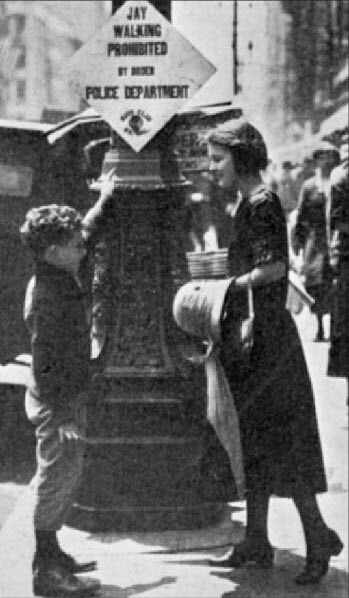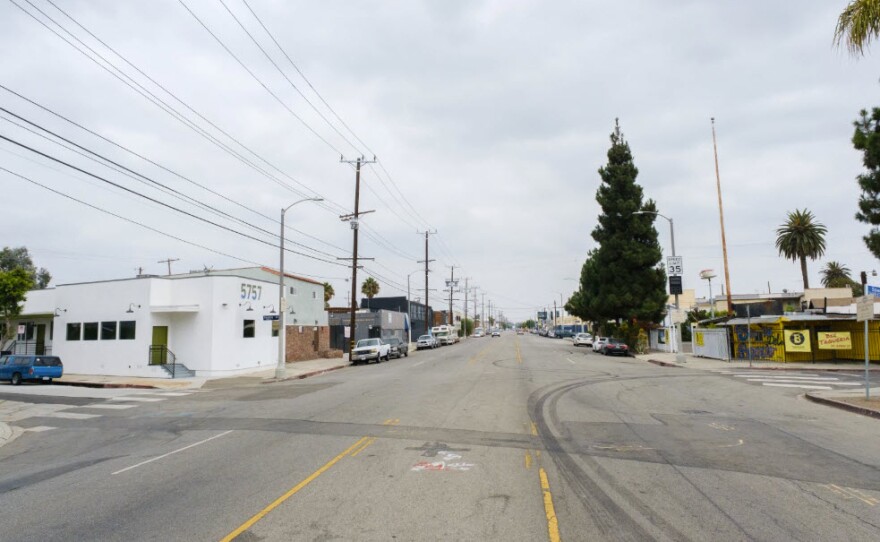Despite some headlines you might see this week about “jaywalking” being decriminalized or made legal in California, the bill signed late last week by Gov. Gavin Newsom does not technically decriminalize it.
The Freedom to Walk Act does aim to protect pedestrians from “jaywalking” tickets when they cross a street outside of a crosswalk or against a traffic light (and let's be honest, most everyone has done this at some point).
But you must meet specific conditions to be in the clear. AB 2147 states that police officers should not stop and cite a crossing pedestrian “unless a reasonably careful person would realize there is an immediate danger of a collision with a moving vehicle or other device moving exclusively by human power" (such as a bicycle).
“It's still technically illegal to cross the street in the middle of the street,” Assemblymember Phil Ting (D-San Francisco), one of the bill’s authors, explained to LAist. “But we're directing law enforcement not to cite people, unless there's an immediate hazard.”
The bill, co-authored by Assemblymember Laura Friedman (D-Glendale), will take effect January 1, 2023.
This was the second attempt to change the way “jaywalking” is enforced in the state. Newsom vetoed a previous version of the bill last year, citing concerns that decriminalizing “jaywalking” would “unintentionally reduce pedestrian safety and potentially increase fatalities or serious injuries.”
So what is an 'immediate danger?'
You might be wondering: how can the state ensure equitable enforcement if it's up to individual police officers to decide what's an “immediate danger?”
Ting acknowledged that the version of the bill that will become law in a few months will lead to “enforcement that's not completely uniform.”
"I preferred our bill last year. I think it was much cleaner, easier to implement. But this is the version that we were able to settle."Assemblymember Phil Ting, D-San Francisco
Local mobility advocates also have concerns that the new law relies too much on officers' judgment.
“There's still that piece of officer discretion,” said Tamika Butler, a social justice advocate and private consultant focused on equitable transportation policy. “As a Black person in this country, officer discretion has never gone well.”
John Yi, executive director of the local pedestrian advocacy group Los Angeles Walks, also has worries about enforcement.
“If we have policies in gray areas, who are the people that are screwed over the most?” he asked. “It's usually people of color, pedestrians, people without political social capital.”
Black pedestrians are cited disproportionately
The Freedom to Walk Act was designed to reduce inequitable enforcement of jaywalking laws and minimize encounters with armed police. Police in Los Angeles, for example, cite Black pedestrians at a rate over three times their population share in the city, according to analysis of LAPD data.
In our reporting on last year’s version of the bill, we examined LAPD citation records from 2010 to 2020, categorized by ethnicity. We found that 31.5% of the jaywalking tickets issued in that time were given to Black pedestrians, in a city with a roughly 9% Black population.
White, Latino or Hispanic and Asian pedestrians were all cited at lower rates when compared to their population shares in L.A. Pedestrians who identified as Indigenous, Native Hawaiian, Native Alaskan or Pacific Islander represented about 0.07% of citations. Combined, those communities represent about 0.9% of the city’s population.
Butler said the push for racial justice in traffic enforcement is important, especially with “jaywalking” and other traffic infractions that are “used as a new version of stop-and-frisk.”
“Getting this version of [the bill] signed, I think just creates a level of accountability,” she said.
“People will be watching, people will want to know: does this really change things? That will be the true test on if this goes far enough. In my opinion, I don't think it does enough to protect Black lives.”Tamika Butler, a social justice advocate and private consultant
Why do we call it ‘jaywalking?’

The word “jay” is early-1900s slang, which basically means an idiot from the country. The term was weaponized by the early auto industry to shame and victim-blame pedestrians, who drivers were killing at alarming rates in those early decades of automobile use.
Then in the mid-1920s, automakers and their interest groups orchestrated a traffic ordinance in Los Angeles, which the city adopted, that greatly limited pedestrian movement. That ordinance became the template for cities nationwide. “Jaywalking” laws spread and our streets were reshaped into the car-centric spaces they are today.
As historian Peter Norton told me in 2021, “jaywalking” laws took the normal and necessary act of walking in public and turned it “into a marginalized, restricted, limited practice that — if you didn't do it exactly the right way — could get you a ticket, or worse.”
The underlying issue
Mobility advocates argue the inequitable enforcement of “jaywalking” seen in L.A. and other cities stems from a history of inequitable investments in safety infrastructure.
The neighborhoods where pedestrians are cited the most are largely the same communities with fewer crosswalks, bike lanes and other features intended to make streets safer. They’re also the communities where more residents are killed by drivers while walking.
And the fines add up, particularly for people already struggling to make ends meet. The base fine for jaywalking in California is $25. But then 10 additional penalties and surcharges get tacked on to that fine, bringing a basic jaywalking ticket to just shy of $200.
“You can't give people tickets for riding their bikes on the sidewalk or for jaywalking (when) there's no infrastructure, there's no crosswalk in their neighborhood, there's no bike lane — there's nothing,” Butler said.
Collision data compiled by the LAPD shows that through Sept. 17 this year, 106 pedestrians have been killed by drivers, and 317 more have been severely injured.

Nearly 60% of those victims were killed or injured in South L.A. or the San Fernando Valley — communities the city has acknowledged have long been neglected for street safety improvements.
L.A. transportation officials have noted that the city enacted “systemically racist policies and practices” that harmed Black and Brown Angelenos. A recent Department of Transportation strategic plan states:
“…we spent much more time investing in communities that raise their hands first, rather than communities that need investments the most.”Department of Transportation
A 2020 UCLA study found Black Angelenos represented 16% of all traffic fatalities between 2013 and 2017, nearly double their share of the city's population. Data compiled in the study also showed that one in every four people killed in a crash over those five years was either a Black or Latino pedestrian.
What's next
Yi said this new law “by no means” solves the crisis of pedestrian deaths.
“The only way we're going to reduce people being killed from jaywalking is to fix our freakin’ streets,” he said, adding:
“Unless we fix the actual design of the streets, we’ll have the same outcomes… This in itself will not save L.A., will not save Angelenos, will not save pedestrians. This must be part of a larger effort in our city in our state to have better, safer and more walkable infrastructure.”John Yi, Los Angeles Walks
Assemblymember Friedman echoed a stance I’ve heard argued from other elected leaders and safety advocates: citing people for “jaywalking” has little-to-no effect on a pedestrian's behavior and does not improve public safety.
“So why are we doing it so much?” she asked.
“If people are jaywalking a lot in an area, it's probably because they don't have a good way to get across the street," Friedman explained. "I'd rather have communities start thinking about adding more crosswalks, adding better signage, putting a light up, putting up a stop sign, adding a sidewalk — doing all the things that we know actually do make people safer.”






